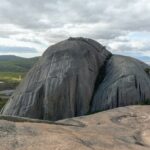Prepare to embark on a journey through the wondrous world of coastal plains, where intriguing secrets and enchanting facts await discovery. From their remarkable geological formations to their diverse and thriving ecosystems, coastal plains hold a wealth of captivating stories that are waiting to be unraveled. In this article, we will delve into the unique characteristics, ecological richness, and cultural significance of these awe-inspiring landscapes, shedding light on the hidden wonders that lie within. Get ready to unlock the coastal plains and uncover fascinating facts that will leave you in awe of these extraordinary natural wonders.
Key Takeaways:
- Coastal plains are low-lying areas of mostly flat land that border the ocean and are separated from the interior by nearby landforms, such as mountains.
- Coastal plains can form either through the accumulation of sediment eroded from the mainland or by the submergence of the continental edge.
- Coastal plains feature unique plant and animal habitats, as well as interesting geological features like long sandy beaches, rolling hills, and fertile farmland. Some of the largest coastal plains can be found in Alaska and the southeastern United States, such as the Gulf Coastal Plain of North America.
- The Gulf Coastal Plain stretches for about 981 miles (1,579 km) along the Lower Mississippi River to the Ohio River. It showcases diverse ecosystems and is home to a variety of animals and plants, including the American alligator, the American bald eagle, and the sugar maple.
- Coastal plains are not only geologically significant but also ecologically important due to their distinct plant and animal life.
- Conservation efforts should be made to recognize and protect the remarkable landscapes of coastal plains.
Learn More:
– National Geographic Society: www.nationalgeographic.org/encyclopedia/coastal-plain
– Wise-Answer: What are facts about coastal plains?: wise-answer.com/what-are-facts-about-coastal-plains
Facts About the Coastal Plains

Coastal plains are captivating landscapes that showcase a remarkable blend of natural wonders, diverse ecosystems, and rich cultural heritage. Located along the edges of continents, where land meets the ocean, these low-lying areas are full of intriguing features that make them worth exploring. Let’s dive into some fascinating facts about coastal plains.
Coastal Plains: Definition and Formation
Coastal plains are characterized by their low and mostly flat terrain, stretching alongside the ocean. These areas are typically separated from the rest of the interior by nearby landforms, such as mountains[^1^]. They can form in two primary ways: through the accumulation of sediment eroded from the mainland or by the submergence of the continental edge[^1^]. Take, for example, the western coast of South America, where a vast coastal plain lies between the Andes Mountains and the Pacific Ocean[^2^].
Unique Characteristics and Habitats
Coastal plains offer a wealth of distinctive plant and animal habitats, as well as interesting geological features. These regions are renowned for their long sandy beaches, rolling hills, and fertile farmland, contributing to their diverse ecosystems[^2^][^6^]. Some of the largest coastal plains can be found in Alaska and the southeastern United States, such as the Gulf Coastal Plain in North America[^4^].
Exploring the Gulf Coastal Plain
One of the prominent coastal plains worth highlighting is the Gulf Coastal Plain. Extending northwards from the Gulf of Mexico along the Lower Mississippi River to the Ohio River, this expansive coastal plain covers an impressive distance of about 981 miles (1,579 km)[^4^]. What makes this coastal plain so captivating is its rich biodiversity and varied landscape. It provides a habitat for an array of fascinating species, including the American alligator, the American bald eagle, and the sugar maple[^6^].
Conservation and Significance
Coastal plains hold not only geological and geographical significance but also ecological importance owing to their distinct plant and animal life. Preserving these unique landscapes is vital to safeguard the diverse ecosystems they sustain. Efforts in conservation and environmental awareness are crucial to protecting the rich cultural heritage and natural wonders found within coastal plains.
Learn More
To delve deeper into the topic of coastal plains and their significance, consider visiting the following resources:
- National Geographic Society
- Wise-Answer: What are facts about coastal plains?
Explore the wonders of coastal plains, unveil their captivating features, and expand your knowledge about these extraordinary landscapes. Join the journey today and embark on a fascinating exploration of the coastal plains.
Check out these fascinating facts on architecture. You won’t believe what you’ll discover! facts on architecture
Did you know that macarons have a rich history and are beloved worldwide? Explore some intriguing facts about macarons. facts about macarons
Embark on a journey to the ancient world with these captivating facts about the Karnak Temple. Uncover its secrets now! facts about Karnak Temple
Craving something sweet? Delve into the delectable world of churros and unearth some mouthwatering facts. facts about churros
Are you a fan of boba? Discover the fascinating facts behind this trendy beverage that has taken the world by storm. facts about boba
Get ready for some slimy fun! Dive into the mesmerizing world of slime and uncover some mind-boggling facts. facts about slime
Explore the enchanting coastal plains and learn intriguing facts about these unique natural landscapes. Start your adventure now! facts about coastal plains
Uncover the mysteries of the Maya civilization with these interesting facts that will leave you in awe. Don’t miss out! interesting facts about the Maya civilization
Discover the hidden gems of Chad with these fascinating facts that will transport you to this captivating country. Begin your exploration now! interesting facts about Chad
Indulge in some dessert knowledge with these delightful facts that will satisfy your craving for sweet insights. Dig in! dessert facts
Ecological Diversity and Importance
Coastal plains, the low-lying areas where land meets the ocean, are teeming with ecological diversity and hold immense importance. These unique landscapes, characterized by flat terrains and diverse ecosystems, play a crucial role in supporting a wide array of plant and animal species. Let’s dive deeper into the fascinating facts about the ecological diversity and importance of these coastal plains.
A Global Hotspot of Biodiversity
One remarkable coastal plain that stands out for its ecological richness is the North Atlantic Coastal Plain. Cascading from New York to Florida, this region has earned its reputation as a global diversity hotspot. [^1^] It serves as a critical habitat for countless species, making it of immense importance for conservation efforts. The lush coastal habitats, including mangroves, estuaries, coral reefs, seagrass beds, and beaches, foster a remarkable abundance of flora and fauna.
A Haven for Migratory Birds
Coastal plains also provide vital resting and feeding grounds for migratory birds during their long journeys across the globe. These avian travelers rely on the coastal plains’ rich resources to refuel their energy and continue their arduous migrations. The abundance of marshes, swamps, and wetlands in coastal plains serves as crucial stopover points, ensuring the survival of many bird species. Such ecological dynamics emphasize the importance of these coastal plains in preserving biodiversity.
Supporting Marine Life
Beyond the vibrant birdlife, coastal plains serve as breeding grounds and nurseries for marine organisms. The complex networks of estuaries and mangroves provide ideal environments for the reproduction and growth of various marine species. These intricate ecosystems are home to a diverse range of fish, crustaceans, mollusks, and more. The intricate balance within these coastal plains ensures the sustainability of marine life, making them an essential part of our planet’s ecological tapestry.
The Economical Backbone
Apart from their ecological significance, coastal plains contribute significantly to the economy. Industries such as fishing, tourism, and agriculture heavily rely on the resources provided by these regions. The plentiful fish stocks lure fishermen, attracting locals and tourists alike. Coastal tourism flourishes as visitors flock to witness the breathtaking beauty and engage in recreational activities. Moreover, the fertile soil of coastal plains supports agriculture, providing sustenance to communities and enhancing local economies. The economic interplay with these coastal plains highlights their invaluable importance.
Key Takeaways:
- Coastal plains, the low-lying areas along the edges of continents, are rich in ecological diversity and importance.
- The North Atlantic Coastal Plain is recognized as a global biodiversity hotspot, showcasing its ecological significance.
- Coastal plains serve as vital habitats for migratory birds and breeding grounds for marine organisms.
- These plains support industries like fishing, tourism, and agriculture, playing a crucial role in the economy.
CITATIONS:
– National Geographic Society – Coastal Plain
– Sciencing – Facts on the Atlantic Coastal Plains
Cultural Significance and Human Interactions
Coastal plains have more to offer than just their stunning landscapes and diverse ecosystems. They hold immense cultural significance and have been the site of various human interactions throughout history. Let’s delve deeper into the fascinating facts about the cultural significance and human interactions within coastal plains.
Historic Human Habitation and Cultural Development
The coastal plains have witnessed the development of vibrant human communities, stretching along the Atlantic coast from New Jersey to Florida. Native American tribes, such as the Plateau Indian peoples and numerous others, called these coastal plains home. They built settlements, developed intricate cultures, and spoke diverse languages[^1][^12]. These tribes left a lasting imprint on the coastal plain region, shaping its cultural heritage.
Rich Archaeological and Historical Significance
The long history of human habitation in the coastal plains has left behind a treasure trove of archaeological and historical artifacts. Excavations have revealed ancient settlements, artifacts, and evidence of human activities that provide valuable insights into the lives and cultures of past coastal plain communities[^2]. Exploring these archaeological sites allows us to better understand the fascinating past of the coastal plains and their inhabitants.
Human Impacts on Coastal Environments
As coastal plains attract human populations, their environments inevitably undergo changes. Approximately 40% of the world’s coastlines have been affected by human activity[^3]. Construction projects like groins, jetties, and seawalls have altered wave refraction patterns along coastal fringes[^5]. These human interventions, though serving various purposes, have significant effects on the coastal environment.
Coastal Communities and Connection to the Ocean
Coastal communities play a crucial role in the cultural heritage and interaction of humans with the ocean. Their relationship with the sea influences their identity, livelihoods, and wellbeing[^11]. Culture and traditions are often intertwined with the ocean and coast, shaping the resilience of cultural heritage and the unity or division of coastal communities[^7]. Understanding the complexities of ocean-human relationships requires a transdisciplinary approach that encompasses social, cultural, and environmental factors[^11].
Key Takeaways:
- The coastal plains were home to Native American tribes, who developed settled villages, diverse cultures, and different languages[^1].
- Coastal plains have significant archaeological and historical value, providing insights into past human communities[^2].
- Human activities, such as construction projects, have modified wave patterns along coastal fringes[^5].
- Coastal communities have a deep connection to the ocean, influencing their identity, livelihoods, and wellbeing[^11].
Sources:
– Sciencing – People of Coastal Plains
– Facts.net – Extraordinary Facts About Coastal Plains
Threats and Conservation Efforts
Coastal plains are unique ecosystems that are rich in biodiversity and cultural significance. However, these delicate landscapes are facing various threats that require immediate conservation efforts. In this article, we will explore the threats faced by coastal plains and the ongoing conservation initiatives aimed at preserving these valuable habitats.
Threats to Coastal Plains
Coastal plains, especially those in the North American region, are encountering several significant threats that jeopardize their ecological balance and overall health. Let’s delve into some of these threats:
- Suppression of Natural Fires: Over the years, natural fires have been suppressed in the North American Coastal Plain, leading to the overgrowth of scrub in savannas, pine barrens, and woodlands. This overgrowth reduces habitat quality and limits plant growth[^1].
- Deforestation for Agriculture and Infrastructure: The demand for agriculture and infrastructure development has resulted in widespread deforestation in coastal plains. This destruction of habitats leads to the loss of valuable biodiversity and disrupts the delicate balance of these ecosystems[^2].
- Global Climate Change: Coastal plains, particularly vulnerable habitats like the Florida mangroves, are experiencing the adverse impacts of global climate change. Rising sea levels, increased temperatures, and changing weather patterns are causing habitat loss and threatening the survival of numerous species[^3].
- Conversion of Habitats into Agricultural Land: As coastal plains are converted into agricultural lands, the use of pesticides becomes a significant concern. These chemicals can harm the species within the region and disrupt the delicate ecological balance[^4].
- Coastal Communities: Coastal communities face numerous threats such as extreme natural events, coastal erosion, sea level rise, and floods[^5]. These events not only impact human lives and infrastructure but also have implications for the surrounding ecosystems.
- Marine Ecosystems: Marine ecosystems in coastal areas are vulnerable to various threats, including habitat loss, pollution, overfishing, and climate change. These pressures put immense stress on the marine life and disrupt the delicate balance of these ecosystems[^6].
Conservation Efforts
Recognizing the importance of coastal plains and the urgent need for their preservation, numerous conservation efforts have been undertaken. Here are some of the initiatives aimed at protecting these valuable ecosystems:
- Biodiversity Hotspots: The North American Coastal Plain is recognized as the planet’s 36th biodiversity hotspot[^8]. This designation brings attention and resources to the region, facilitating targeted conservation efforts and protection of key habitats.
- Coastal Wetland Conservation: Coastal wetlands, including mangroves, coral reefs, salt marshes, and sea grass beds, are frequently threatened from both land and sea. Conservation organizations are working towards restoring and protecting these critical habitats that provide numerous ecological benefits.
- Land Use Planning and Regulation: Effective land use planning and regulation play a vital role in protecting coastal plains. By designating protected areas, implementing zoning laws, and promoting sustainable land practices, conservation efforts can ensure the long-term viability of these ecosystems.
- Climate Change Adaptation: To tackle the challenges posed by climate change, coastal communities and conservation organizations are implementing measures to adapt and mitigate its impacts. These efforts include the restoration of barrier islands, reforestation projects, and the establishment of climate-resilient infrastructure.
- Education and Awareness: Promoting environmental education and raising awareness about the value of coastal plains are crucial in fostering a sense of responsibility towards their conservation. By engaging communities and stakeholders, conservation efforts can be strengthened and embraced by a wider audience.
Key Takeaways:
- Coastal plains face threats from the suppression of natural fires, deforestation, climate change, conversion of habitats, extreme natural events, and pollution[^1][^2][^3][^4][^5][^6].
- Conservation efforts focus on biodiversity hotspots, coastal wetland conservation, land use planning and regulation, climate change adaptation, education, and awareness[^8][^9][^10][^11][^13].
Sources:
[^1] CEPF – Threats
[^2] NOAA’s National Ocean Service – Coastal Threats
[^3] IUCN – Marine Ecosystems in the Coastal Plains
[^4] National Geographic Society – Coastal Plain
[^5] CEPF – North American Coastal Plain
[^6] Pew Trusts – Coastal Habitats in the United States
[^7] CDN Science Pub – Coastal Wetlands
[^8] Springer – Land-Based Changes in Coastal Ecosystems

FAQ
Q1: What are coastal plains and how are they formed?
A1: Coastal plains are low-lying areas of land that stretch along the edges of continents, where land meets the ocean. They can form either through the accumulation of sediment eroded from the mainland or through the submergence of the continental edge.
Q2: What are some unique features of coastal plains?
A2: Coastal plains are characterized by their long, sandy beaches, rolling hills, and fertile farmland. They can also feature interesting geological formations. The Gulf Coastal Plain of North America, for example, showcases diverse ecosystems and is home to a variety of animals and plants.
Q3: Why are coastal plains ecologically important?
A3: Coastal plains support diverse plant and animal species, serving as vital habitats for migratory birds and breeding grounds for marine organisms. Their rich biodiversity is important for ecological stability.
Q4: What are the threats to coastal plains?
A4: Coastal plains face threats such as habitat loss due to deforestation for agriculture and infrastructure development, suppression of natural fires leading to overgrowth, climate change impacting vulnerable habitats like mangroves, and the conversion of habitats into agricultural land leading to pesticide use.
Q5: What are the potential impacts of human activity on coastal plains?
A5: Human activities along coastal plains can have both positive and negative impacts. Positive impacts include industries such as fishing, tourism, and agriculture, which contribute to the local economy. Negative impacts include changes in coastal environments, such as the modification of wave refraction patterns, and the overall risk of coastal erosion and sea level rise that coastal communities may face.
- Sept 31 Myth: Unveiling Calendar Secrets - March 18, 2025
- How Long & Till December 18, 2025: Accurate Countdown Guide - March 18, 2025
- Discover Japanese Artists: A Complete History - March 18, 2025
















